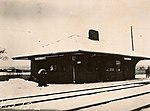Cambridge Discovery Park
Cambridge Discovery Park (also known as "CDP" or "the Park"), formerly known as Acorn Park, is a 30 acres (12 ha) office and laboratory campus in Cambridge, Massachusetts. It is located along Massachusetts Route 2, and is aconnected to the Alewife Red Line subway terminus and bus station by a walking path, and to the Minuteman Bikeway. It was the home office of Arthur D. Little, an international management consulting firm, from 1953 to 2002. Since 2000, CDP has been owned and managed by an affiliate of Bulfinch, a real estate firm. Bulfinch has since redeveloped the office park, positioning it as a "world-class sustainable urban office and research campus". The Park is master-planned for six different LEED-certified office and laboratory buildings totaling up to 820,000 sf and two structured parking garages. It includes green space with walking and bicycle trails as well as two buildings and a parking garage. Cambridge Discovery Park and surrounding Alewife Brook Reservation represents one of the largest campuses in Cambridge (after Harvard and MIT) and is home to tenants including Forrester Research, the Smithsonian Astrophysical Observatory, Siemens, Pfizer, and Genocea Biosciences.
Excerpt from the Wikipedia article Cambridge Discovery Park (License: CC BY-SA 3.0, Authors).Cambridge Discovery Park
Acorn Park Drive, Cambridge
Geographical coordinates (GPS) Address Nearby Places Show on map
Geographical coordinates (GPS)
| Latitude | Longitude |
|---|---|
| N 42.398194444444 ° | E -71.147397222222 ° |
Address
Cambridge Hotel
Acorn Park Drive 10
02475 Cambridge
Massachusetts, United States
Open on Google Maps








